
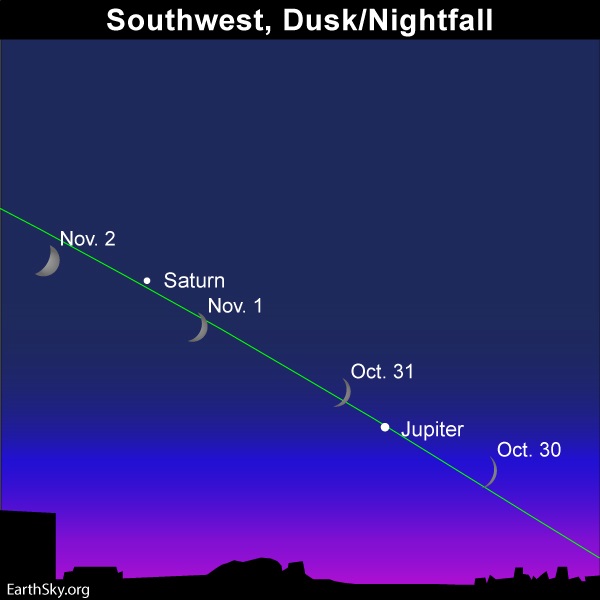
Watch for the young crescent moon near Jupiter on October 30 and 31, and then near Saturn on November 1 and 2. Read more.
Click the name of a planet to learn more about its visibility in November 2019: Venus, Jupiter, Saturn, Mars and Mercury.
Jupiter – the second-brightest planet after Venus – adorns the western sky at dusk and nightfall. Venus lurks below Jupiter nearly all month long, until these two dazzling beauties meet up for a conjunction on November 24, 2019. By the month’s end, Venus will have moved above Jupiter in the evening sky.
Jupiter pops out at dusk – brighter than any star – and stays out until early evening at mid-northern latitudes (mid-evening at temperate latitudes in the Southern Hemisphere). Not sure which one is Jupiter? See the moon in Jupiter’s vicinity for several days, centered on or near Halloween and then again on or near November 27.
Need more confirmation? Find a bright object you think is Jupiter, steady your binoculars – maybe sit down and anchor them on your knees, or prop your elbows on a fence railing – and aim them at that very bright light. If it is Jupiter, at least one or more of its four largest moons should pop into view.
At mid-northern latitudes in the Northern Hemisphere, Jupiter appears in the southwest sky at dusk. In early November, Jupiter sets around 7 to 8 p.m. (8 to 9 p.m. daylight saving time). By the month’s end, Jupiter sets at nightfall, around 6 p.m.
At temperate latitudes in the Southern Hemisphere, the king planet stays out till around 10 p.m. in early November, and by late November, Jupiter sets at nightfall, or around 8 p.m.
Try Stellarium Online for the view from your location.

At nightfall and early evening – November 1 and 2, 2019 – the waxing crescent moon shines in the vicinity of the planet Saturn, and the dazzling planet Jupiter sits below the moon and Saturn, fairly close to the horizon. Read more.
Saturn. After you find Jupiter at dusk and nightfall, use this brilliant beauty of a planet to find another bright evening planet, Saturn. Saturn is not as bright as Jupiter, but the ringed planet shines on a par with the sky’s brightest stars. Hold your fist at arm’s length. Saturn is roughly two fist-widths to the east of (or above) Jupiter. Because Saturn is the only bright-looking “star” to occupy this part of the sky, you’re not likely to mistake a bright star for Saturn.
Read more: When Jupiter and Saturn meet
Saturn – a golden world to the eye alone – pops out at nightfall and stays out well after nightfall. This planet still shines as brightly as a 1st-magnitude star, in other words, as brightly as our sky’s brightest stars.
Viewing Saturn’s rings soon? Read me 1st
At mid-northern latitudes, Saturn plunges below the horizon around 9 p.m. (10 p.m. daylight saving time) in early November. Near the month’s end, Saturn sets around 7 to 8 p.m.
At temperate latitudes in the Southern Hemisphere, in early November, Saturn sinks below the horizon near the midnight hour. (Midnight in this usage means midway between sunset and sunrise.) By the month’s end, Saturn sets around 9 to 10 p.m.
You won’t mistake Jupiter for Saturn. Jupiter is significantly the brighter of these two worlds. The king planet Jupiter ranks as the fourth-brightest celestial object after the sun, moon and Venus, outshining Saturn by about 10 times. What’s more, at nightfall and early evening in November 2019, Jupiter shines well to the west of Saturn.
Watch for the waxing crescent moon to join up with Saturn in early November, as shown on the sky chart above, and then again at the month’s end, as shown on the sky chart below.
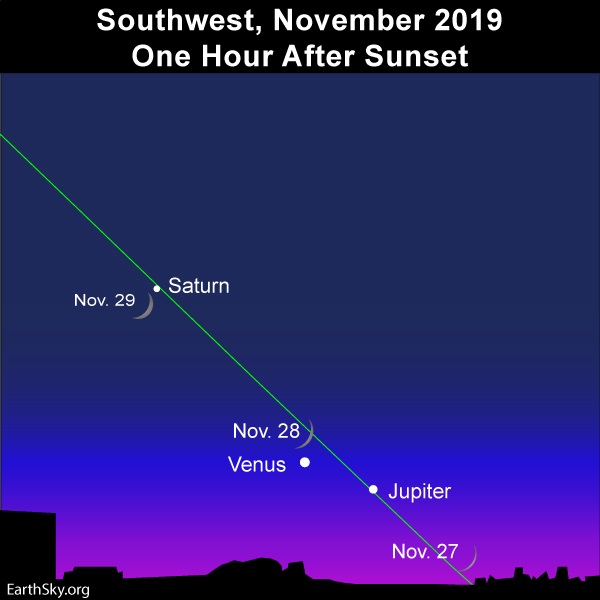
Watch for the young moon to fly by Jupiter, Venus and Saturn in late November 2019. By the month’s end, Venus will have climbed above Jupiter in the evening sky. Read more.
Venus – the brightest planet – climbs out of the glare of evening dusk throughout the month, becoming more prominent in the evening sky in late November. Venus starts out the month below Jupiter, the second-brightest planet after Venus. But watch for Venus to soar upward day by day while Jupiter sinks downward. These two dazzling beauties will meet up for a close-knit conjunction on November 24, 2019, as shown on the sky chart below. By the month’s end, Venus hovers over Jupiter, as she reclaims her stature as the evening “star.”
At mid-northern latitudes in early November, Venus sets about one hour after sunset; but by the month’s end, that’ll increase to nearly two hours.
At temperate latitudes in the Southern Hemisphere, Venus sets about 1 1/2 hours after the sun in early November, and some two hours after sunset by the month’s end.
Watch for the young waxing crescent moon to pair up with Venus on or near November 28, as shown on the chart above.
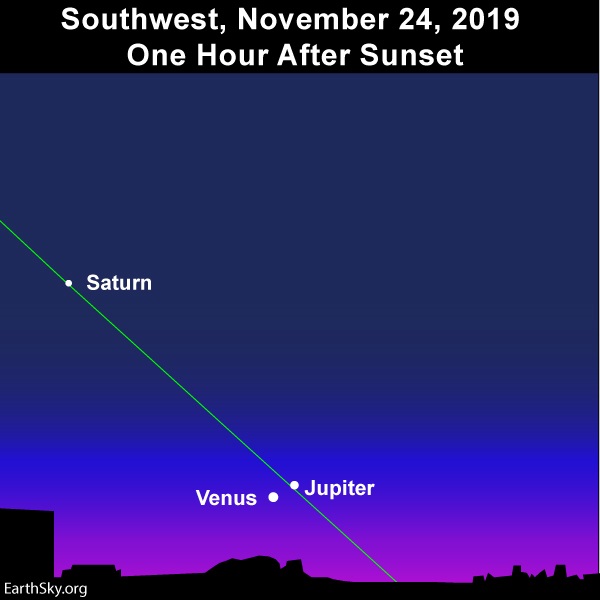
It should be grand viewing Venus and Jupiter in conjunction in the evening twilight on November 24, 2019. After all, Venus and Jupiter rank as the 3rd-brightest and 4th-brightest heavenly bodies, respectively, after the sun and moon. Read more.

Transit of Mercury from San Juan, Puerto Rico – May 9, 2016 – by Fernando Roquel Torres. The next transit of Mercury will take place on November 11, 2019. Read more.
Mercury shifts from the evening sky to the morning sky on November 11, 2019. Most of the time, as seen from Earth, Mercury swings to the north or south of the sun as its transitions over to the morning sky at inferior conjunction (see diagram below). But not this time! Mercury passes directly in front of the sun, to show itself as a small black dot crossing the solar disk. You need an optical aid and proper eye protection to safely watch this transit of Mercury.
Read more: Transit of Mercury on November 11, 2019
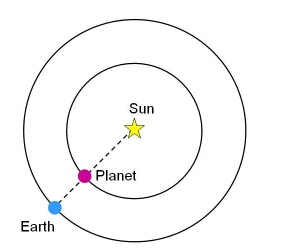
This diagram depicts an inferior conjunction of Venus or Mercury. At such times, the inner planet passes between the Earth and sun. Image via COSMOS.
From southerly latitudes, it may be possible to catch Mercury after sunset in early November; and, from northerly latitudes, to view Mercury before sunrise during the last week or two of November. Watch for the waning crescent moon to pair up with Mercury around November 24 or 25, as shown on the sky chart below.
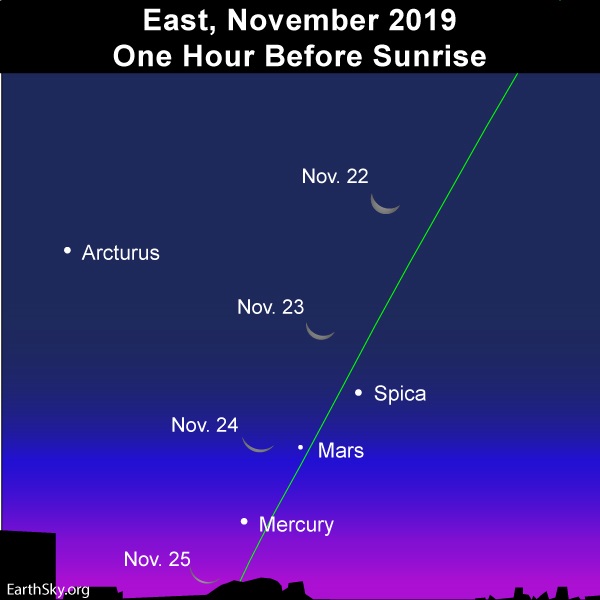
If you’re an early bird, waking up before the sun, then use the moon, the star Regulus and the star Spica to help you envision the ecliptic with the mind’s eye, and to find Mars and Mercury. Read more.
Where is Mars? Sitting in the glare of morning twilight, modestly-bright Mars slowly climbs out the glare of morning twilight throughout November. Mars is more easily seen from the Northern Hemisphere and southern tropics than at temperate latitudes in the Southern Hemisphere. At mid-northern latitudes, Mars rises about two hours before the sun in early November, and by the month’s end, rises some 2 1/2 hours before.
At temperate latitudes in the Southern Hemisphere, Mars comes up about one hour before the sun in early November, and about 1 1/2 hours before sunrise at the month’s end.
Watch for the old waning crescent moon to couple up with Mars on or near November 25, as shown on the above sky chart.
What do we mean by bright planet? By bright planet, we mean any solar system planet that is easily visible without an optical aid and that has been watched by our ancestors since time immemorial. In their outward order from the sun, the five bright planets are Mercury, Venus, Mars, Jupiter and Saturn. These planets actually do appear bright in our sky. They are typically as bright as – or brighter than – the brightest stars. Plus, these relatively nearby worlds tend to shine with a steadier light than the distant, twinkling stars. You can spot them, and come to know them as faithful friends, if you try.
Bottom line: In November 2019, a line-up three planets – Saturn, Jupiter and Venus – adorns the sky at dusk/nightfall, with Saturn at top and Venus at bottom. Day by day, Venus climbs upward, toward Jupiter, until Venus and Jupiter meet up for a conjunction on November 24. Mercury crosses the sun’s disk on November 11. Throughout the month, Mars climbs out of the glare of sunrise. Click here for recommended almanacs; they can help you know when the planets rise and set in your sky.
Don’t miss anything. Subscribe to EarthSky News by email
Visit EarthSky’s Best Places to Stargaze, and recommend a place we can all enjoy.
Help EarthSky keep going! Donate now.
Post your planet photos at EarthSky Community Photos
from EarthSky https://ift.tt/1YD00CF


Watch for the young crescent moon near Jupiter on October 30 and 31, and then near Saturn on November 1 and 2. Read more.
Click the name of a planet to learn more about its visibility in November 2019: Venus, Jupiter, Saturn, Mars and Mercury.
Jupiter – the second-brightest planet after Venus – adorns the western sky at dusk and nightfall. Venus lurks below Jupiter nearly all month long, until these two dazzling beauties meet up for a conjunction on November 24, 2019. By the month’s end, Venus will have moved above Jupiter in the evening sky.
Jupiter pops out at dusk – brighter than any star – and stays out until early evening at mid-northern latitudes (mid-evening at temperate latitudes in the Southern Hemisphere). Not sure which one is Jupiter? See the moon in Jupiter’s vicinity for several days, centered on or near Halloween and then again on or near November 27.
Need more confirmation? Find a bright object you think is Jupiter, steady your binoculars – maybe sit down and anchor them on your knees, or prop your elbows on a fence railing – and aim them at that very bright light. If it is Jupiter, at least one or more of its four largest moons should pop into view.
At mid-northern latitudes in the Northern Hemisphere, Jupiter appears in the southwest sky at dusk. In early November, Jupiter sets around 7 to 8 p.m. (8 to 9 p.m. daylight saving time). By the month’s end, Jupiter sets at nightfall, around 6 p.m.
At temperate latitudes in the Southern Hemisphere, the king planet stays out till around 10 p.m. in early November, and by late November, Jupiter sets at nightfall, or around 8 p.m.
Try Stellarium Online for the view from your location.

At nightfall and early evening – November 1 and 2, 2019 – the waxing crescent moon shines in the vicinity of the planet Saturn, and the dazzling planet Jupiter sits below the moon and Saturn, fairly close to the horizon. Read more.
Saturn. After you find Jupiter at dusk and nightfall, use this brilliant beauty of a planet to find another bright evening planet, Saturn. Saturn is not as bright as Jupiter, but the ringed planet shines on a par with the sky’s brightest stars. Hold your fist at arm’s length. Saturn is roughly two fist-widths to the east of (or above) Jupiter. Because Saturn is the only bright-looking “star” to occupy this part of the sky, you’re not likely to mistake a bright star for Saturn.
Read more: When Jupiter and Saturn meet
Saturn – a golden world to the eye alone – pops out at nightfall and stays out well after nightfall. This planet still shines as brightly as a 1st-magnitude star, in other words, as brightly as our sky’s brightest stars.
Viewing Saturn’s rings soon? Read me 1st
At mid-northern latitudes, Saturn plunges below the horizon around 9 p.m. (10 p.m. daylight saving time) in early November. Near the month’s end, Saturn sets around 7 to 8 p.m.
At temperate latitudes in the Southern Hemisphere, in early November, Saturn sinks below the horizon near the midnight hour. (Midnight in this usage means midway between sunset and sunrise.) By the month’s end, Saturn sets around 9 to 10 p.m.
You won’t mistake Jupiter for Saturn. Jupiter is significantly the brighter of these two worlds. The king planet Jupiter ranks as the fourth-brightest celestial object after the sun, moon and Venus, outshining Saturn by about 10 times. What’s more, at nightfall and early evening in November 2019, Jupiter shines well to the west of Saturn.
Watch for the waxing crescent moon to join up with Saturn in early November, as shown on the sky chart above, and then again at the month’s end, as shown on the sky chart below.

Watch for the young moon to fly by Jupiter, Venus and Saturn in late November 2019. By the month’s end, Venus will have climbed above Jupiter in the evening sky. Read more.
Venus – the brightest planet – climbs out of the glare of evening dusk throughout the month, becoming more prominent in the evening sky in late November. Venus starts out the month below Jupiter, the second-brightest planet after Venus. But watch for Venus to soar upward day by day while Jupiter sinks downward. These two dazzling beauties will meet up for a close-knit conjunction on November 24, 2019, as shown on the sky chart below. By the month’s end, Venus hovers over Jupiter, as she reclaims her stature as the evening “star.”
At mid-northern latitudes in early November, Venus sets about one hour after sunset; but by the month’s end, that’ll increase to nearly two hours.
At temperate latitudes in the Southern Hemisphere, Venus sets about 1 1/2 hours after the sun in early November, and some two hours after sunset by the month’s end.
Watch for the young waxing crescent moon to pair up with Venus on or near November 28, as shown on the chart above.

It should be grand viewing Venus and Jupiter in conjunction in the evening twilight on November 24, 2019. After all, Venus and Jupiter rank as the 3rd-brightest and 4th-brightest heavenly bodies, respectively, after the sun and moon. Read more.

Transit of Mercury from San Juan, Puerto Rico – May 9, 2016 – by Fernando Roquel Torres. The next transit of Mercury will take place on November 11, 2019. Read more.
Mercury shifts from the evening sky to the morning sky on November 11, 2019. Most of the time, as seen from Earth, Mercury swings to the north or south of the sun as its transitions over to the morning sky at inferior conjunction (see diagram below). But not this time! Mercury passes directly in front of the sun, to show itself as a small black dot crossing the solar disk. You need an optical aid and proper eye protection to safely watch this transit of Mercury.
Read more: Transit of Mercury on November 11, 2019

This diagram depicts an inferior conjunction of Venus or Mercury. At such times, the inner planet passes between the Earth and sun. Image via COSMOS.
From southerly latitudes, it may be possible to catch Mercury after sunset in early November; and, from northerly latitudes, to view Mercury before sunrise during the last week or two of November. Watch for the waning crescent moon to pair up with Mercury around November 24 or 25, as shown on the sky chart below.

If you’re an early bird, waking up before the sun, then use the moon, the star Regulus and the star Spica to help you envision the ecliptic with the mind’s eye, and to find Mars and Mercury. Read more.
Where is Mars? Sitting in the glare of morning twilight, modestly-bright Mars slowly climbs out the glare of morning twilight throughout November. Mars is more easily seen from the Northern Hemisphere and southern tropics than at temperate latitudes in the Southern Hemisphere. At mid-northern latitudes, Mars rises about two hours before the sun in early November, and by the month’s end, rises some 2 1/2 hours before.
At temperate latitudes in the Southern Hemisphere, Mars comes up about one hour before the sun in early November, and about 1 1/2 hours before sunrise at the month’s end.
Watch for the old waning crescent moon to couple up with Mars on or near November 25, as shown on the above sky chart.
What do we mean by bright planet? By bright planet, we mean any solar system planet that is easily visible without an optical aid and that has been watched by our ancestors since time immemorial. In their outward order from the sun, the five bright planets are Mercury, Venus, Mars, Jupiter and Saturn. These planets actually do appear bright in our sky. They are typically as bright as – or brighter than – the brightest stars. Plus, these relatively nearby worlds tend to shine with a steadier light than the distant, twinkling stars. You can spot them, and come to know them as faithful friends, if you try.
Bottom line: In November 2019, a line-up three planets – Saturn, Jupiter and Venus – adorns the sky at dusk/nightfall, with Saturn at top and Venus at bottom. Day by day, Venus climbs upward, toward Jupiter, until Venus and Jupiter meet up for a conjunction on November 24. Mercury crosses the sun’s disk on November 11. Throughout the month, Mars climbs out of the glare of sunrise. Click here for recommended almanacs; they can help you know when the planets rise and set in your sky.
Don’t miss anything. Subscribe to EarthSky News by email
Visit EarthSky’s Best Places to Stargaze, and recommend a place we can all enjoy.
Help EarthSky keep going! Donate now.
Post your planet photos at EarthSky Community Photos
from EarthSky https://ift.tt/1YD00CF


Aucun commentaire:
Enregistrer un commentaire